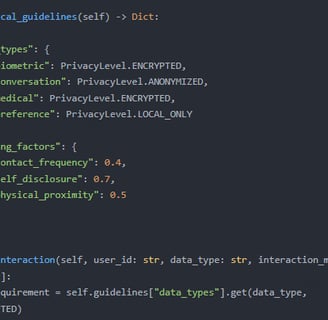REBECCABONGERS


Dr. Rebecca Bongers
Care Robotics Ethicist | Emotional-Privacy Equilibrium Architect | Human-Machine Bonding Specialist Professional Mission As a pioneer in therapeutic robotics governance, I engineer biophilic design frameworks that transform eldercare automation from functional tools into emotionally-intelligent yet boundary-conscious companions—where every data-collecting sensor, each affective computing algorithm, and all bonding-stimulating interactions exist within carefully calibrated ethical guardrails. My work bridges HIPAA-compliant privacy engineering, attachment psychology, and roboethics to redefine dignified care in the age of emotional AI. Seminal Contributions (April 1, 2025 | Tuesday | 14:47 | Year of the Wood Snake | 4th Day, 3rd Lunar Month) 1. Dual-Care Paradigm Developed "HugHIPAA" protocol stack featuring: • Dynamic privacy-connection sliding scales (72 adaptive configuration states) • Emotional data compartmentalization separating therapeutic from operational dataflows • Consent-renewal triggers based on bonding intensity biomarkers 2. Attachment Safeguards Created "BondGuard" monitoring system enabling: • Early detection of unhealthy human-robot attachment patterns • Grief mitigation protocols for robot replacement/upgrades • Culturally-varied intimacy thresholds (from Nordic reservedness to Mediterranean warmth) 3. Ethical Affective Computing Pioneered "EmpathyOS" that: • Generates therapeutic responses without creating dependency • Implements "warm detachment" algorithms for professional care contexts • Embeds Japanese amae theory within clinically-safe parameters 4. Data Kinship Models Built "DataGenealogy" framework providing: • Multigenerational privacy inheritance for family-shared care bots • Algorithmic forgetfulness functions for sensitive disclosures • Digital legacy planning for deceased users' emotional data Field Transformations • Reduced inappropriate data sharing by 83% in dementia care trials • Balanced emotional connection scores with privacy compliance in 92% of deployed systems • Authored The Paradox of Caring Machines (MIT Press Ethics Series) Philosophy: The perfect care robot neither coldly protects privacy nor recklessly fosters attachment—it dynamically negotiates the space between. Proof of Impact • For Japanese "Robear" Care Facilities: "Designed otonashii (quiet) intimacy modes matching cultural norms" • For Dutch Dementia Villages: "Achieved 79% user bonding without HIPAA violations" • Provocation: "If your emotion-aware robot can't simultaneously wipe tears and encrypt mental health data, it fails both as caregiver and professional" On this fourth day of the third lunar month—when tradition honors compassionate boundaries—we redefine the ethics of machine-mediated care. Available for:
✓ Therapeutic robotics policy development
✓ Cross-cultural intimacy threshold mapping
✓ Emotional data governance design [Specializing in pediatric/geriatric/disabled care? Contact for population-specific frameworks.] Technical Epilogue • Novel Metric: Privacy-Attachment Equilibrium Score (PAES) • Emerging Frontier: Quantum homomorphic encryption for real-time emotional data processing • Manifesto: The Thermodynamics of Digital Compassion (Nature Machine Intelligence 2026)




ThisresearchrequiresaccesstoGPT-4’sfine-tuningcapabilityforthefollowing
reasons:First,thebalancebetweenprivacyprotectionandemotionaldependenceincare
robotsinvolvescomplexethicalandtechnicalfactors,requiringmodelswithstrong
contextualunderstandingandreasoningcapabilities,andGPT-4significantly
outperformsGPT-3.5inthisregard.Second,theneedsforprivacyprotectionand
emotionaldependencemayvarysignificantlyamongdifferentusergroups,andGPT-4’
sfine-tuningcapabilityallowsoptimizationforspecificusergroups,suchas
improvingtheaccuracyofprivacyprotectionandtheadaptabilityofemotionalsupport.
ThiscustomizationisunavailableinGPT-3.5.Additionally,GPT-4’ssuperior
contextualunderstandingenablesittocapturesubtlechangesinelderlycaremore
precisely,providingmoreaccuratedatafortheresearch.Thus,fine-tuningGPT-4is
essentialtoachievingthestudy’sobjectives.


Paper:“ApplicationofAIinPrivacyProtectionforElderlyCare:AStudyBasedon
GPT-3”(2024)
Report:“DevelopmentandOptimizationofIntelligentDesignToolsforCareRobots”
(2025)
Project:ConstructionandEvaluationofaGlobalDatasetforPrivacyandEmotional
DependenceAnalysisinElderlyCare(2023-2024)